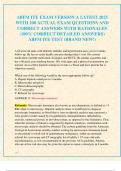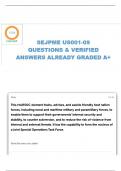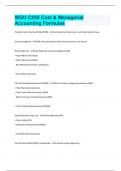ABFM ITE EXAM VERSION A LATEST 2025
WITH 200 ACTUAL EXAM QUESTIONS AND
CORRECT ANSWERS WITH RATIONALES
(100% CORRECT DETAILED ANSWERS)
ABFM ITE TEST (BRAND NEW!)
A 60 year old male with diabetes mellitus and hypertension sees you for routine
follow up. He has no acute health concerns during today's visit. His current
medications include metformin, lisinopril, and HCTZ. He smokes cigarettes and
has a 40 pack year smoking history. His vital signs and a physical examination are
normal. An in-office dipstick urinalysis reveals 1+ blood and trace protein but is
otherwise normal.
Which one of the following would be the most appropriate follow up?
A. Repeat dipstick urinalysis in 3 months
B. Microscopic urinalysis
C. Renal ultrasonography
D. CT urography
E. Referral for cystoscopy
ANSWER: B. Microscopic urinalysis
Rationale: Microscopic hematuria also known as microhematuria, is defined as >3
RBCs/hpf on microscopy. Dipstick analysis alone is insufficient to diagnose
microscopic hematuria, as blood that is seen on dipstick analysis may represent a
false positive result caused by myoglobinuria, hemoglobinuria, dehydration,
exercise, menstrual period, or povidone iodine, as opposed to true hematuria. Thus,
when the presence of blood is suggested by dipstick urinalysis, confirmation with
microscopic analysis should be obtained. The current guideline from the American
Urological Association stratifies further workup for microscopic hematuria based
on the patient's overall risk of genitourinary malignancy, rather an automatic
referral for cystoscopy and CT urography for all adults > 35 years old with
microhematuria, as was recommended in the previous AUA guideline. Patients
who are at low risk also may be given the option to repeat a urinalysis in 6 months.
pg. 1
,For this patient the next step would be microscopic urinalysis to determine the
presence of hematuria, and if present, to quantify it. If microscopic UA confirms
the presence of hematuria, then CT urography and cystoscopy would be indicated,
as his age, male sex, and smoking history place him at increased risk of
malignancy. Repeating the dipstick analysis in 3 months would be inappropriate in
this situation, as the presence or absence of true microscopic hematuria needs to be
clarified because of his high risk history.
A 33 year old gravida 2 para 1 presents to the hospital at 35 weeks estimated
gestation with premature rupture of membranes. A decision is made to manage the
pregnancy expectantly and delay delivery unless signs of infection or fetal distress
are noted.
Based on current evidence, expectant management rather than immediate delivery
increases the risk of which one of the following complications?
A. cesarean delivery
B. antepartum or postpartum maternal hemorrhage
C. time spent in the neonatal intensive care unit
D. Neonatal sepsis
E. Perinatal or infant mortality
ANSWER: B. antepartum or postpartum maternal hemorrhage
Rationale: While historically the optimal management of premature rupture of
membranes between 34 and 36 weeks has been unclear, based on the PPROMT
trial published in 2015, expectant management appears to be associated with better
neonatal outcomes. Expectant management decreases the risk of cesarean delivery,
neonatal respiratory distress, mechanical ventilation, time spent in the NICU, and
time spent in the hospital. Expectant management did increase the risk of maternal
antepartum or postpartum hemorrhage and intrapartum fever. No differences were
found between immediate delivery and expectant management in the risk of
neonatal sepsis, pneumonia, or perinatal or infant mortality.
Which one of the following represents a CONTRAINDICATION to statin use?
A. Current pregnancy
B. Chronic hepatitis C infection
C. End stage renal disease
D. Myositis associated with a creatine kinase level five times the upper limit of
pg. 2
,normal
E. Transaminitis due to nonalcoholic steatohepatitis
ANSWER: A. Current pregnancy
Rationale: Statins have been associated with fetal anomalies and are
contraindicated during pregnancy and not recommended during breastfeeding.
With appropriate monitoring, statins may be used in patients with chronic hepatitis
C infection, ESRD, and transaminitis due to NASH. Statins may also be continued
in the setting of myositis with a creatine kinase up to 10 times the upper limit of
normal, provided that the muscle related symptoms are tolerable to the patient.
A 2 year old female is brought to the urgent care clinic because of a fever. On
examination she has a temperature of 39.7 C (103.5 F). Within a short period of
time while at the clinic she develops a barking cough and respiratory distress, and
you note rapid deterioration of her condition.
Which one of the following is the most likely diagnosis?
A. Bacterial tracheitis
B. Epiglottitis
C. Foreign body aspiration
D. Peritonsillar abscess
ANSWER: A. Bacterial tracheitis
Rationale: This patient has bacterial tracheitis, which includes a high fever,
barking cough, respiratory distress, and rapid deterioration. Epiglottitis has an
acute onset of dysphagia, drooling, and high fever, along with anxiety and a
muffled cough, and typically occurs in children 3-10 years of age. Foreign body
aspiration is associated with an acute onset of choking and drooling. A peritonsillar
abscess would cause a sore throat, fever, and a hot potato voice.
A 24-year-old female comes to your office with a 1-day history of the gradual
onset of non-radiating worsening right lower quadrant abdominal pain, nausea,
emesis, and chills. Her symptoms are minimally relieved with ibuprofen, 400 mg.
Her menstrual period 2 weeks ago was normal. She has not had any dysuria,
vaginal discharge, or change in bowel habits. Her past medical and surgical
histories are notable only for dysmenorrhea managed with an anti-inflammatory
medication as needed. An examination reveals a temperature of 38.1°C (100.6°F),
pg. 3
, discomfort with position change, right lower quadrant abdominal tenderness and
guarding, and diminished bowel sounds. Point-of-care testing shows an elevated
WBC count, and a urinalysis and pregnancy test are negative.
Which one of the following would you recommend at this time?
A) A plain film of the abdomen
B) Abdominal ultrasonography
C) Pelvic ultrasonography with transvaginal ultrasonography if needed
D) CT of the abdomen and pelvis
E) MRI of the abdomen and pelvis
ANSWER: D CT of the abdomen and pelvis
Rationale: This patient has suspected appendicitis, and CT of the abdomen and
pelvis with intravenous contrast is the
preferred initial imaging study. Ultrasonography is preferred in children, but not
adults, as the initial study for suspected appendicitis. Plain radiographs, pelvic
ultrasonography, and MRI are not indicated for this
clinical scenario.
A 45-year-old female comes to your office for an annual health maintenance visit.
She has a family history of type 2 diabetes in her mother and a personal history of
obesity for many years.
If verified with a second test, which one of the following would confirm a
diagnosis of diabetes
mellitus?
A) A hemoglobin A1c of 6.4%
B) A 2-hour plasma glucose level of 190 mg/dL on an oral glucose tolerance test
C) A random glucose level of 190 mg/dL
D) A fasting plasma glucose level of 130 mg/dL
ANSWER: D
A fasting plasma glucose level of 130 mg/dL
Rationale: A diagnosis of type 2 diabetes can be based on any of the following test
results: a hemoglobin A1c 6.5%, a fasting plasma glucose level 126 mg/dL, a 2-
pg. 4






